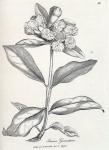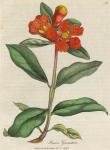
 Synonyma. Granatum. Pharm. Lond. & Edinb.
Synonyma. Granatum. Pharm. Lond. & Edinb.
Malus Punica sativa. Bauh. Pin. p. 438. Park. Theat. p. 1510.
Malus Punica. J. Bauh. Hist. vol. i. p. 76.
Malus Granata sive Punica. Gerard. Emac. p. 1450.
Punica spinosa, foliis nitentibus, ellipticis, integerrimis, floribus sessilibus. Hal. Stirp. Helv. n. 1098. Conf. Du Hamel Traite des arbres, t. 2. p. 193. et Miller Illustr. Syst. Sex.
β Punica floribus plenis.
Theophrasti et Dioscoridi arbor ejusque fructus dicitur (greek);
Hippocrati arbor audit (greek), unde cortex fructus (greek) vel (greek).
Flores Punicae sativae autem Dioscoridi et Galeni (greek) bodie Balaustiorum Flores, vocantur.
Class Icosandria. Ord. Monogynia. Lin. Gen. Plant. 618.
Ess. Gen. Ch. Cal. 5-fidus, superus. Petala 5. Pomum multiloculare polyspermum.
Spec. Char. P. foliis lanceolatis, caule arboreo.
This small tree rises several feet in height: it is covered with a brownish bark, and divided into many small branches, which are armed with spines: the leaves are oblong, or lance-shaped, pointed, veined, of a deep green colour, and placed upon short footstalks: the flowers are large, of a rich scarlet colour, and stand at the end of the young branches: the corolla is composed of five large roundish slender petals, with narrow claws, by which they are inserted into the calyx: the calyx is large, thick, fleshy, tubular, of a brownish red colour, and divided at the extremity into five pointed segments: the filaments are numerous, short, bent inwards, furnished with yellow antherae, and attached to the calyx: the germen is roundish, and supports a simple style, of the length of the filaments, and terminated by a globular stigma: the fruit is about the size of an orange, and crowned with the five teeth of the calyx: the rind is thick and tough, externally reddish, internally yellowish, filled with a red succulent pulp, [This is gratefully acid, somewhat like that of oranges.] contained in transparent cellular membranes, and included in nine cells, within which numerous oblong angular seeds are also lodged. This shrubby tree is a native of Spain, Italy, and Barbary, and flowers from June till September.
The Greek writers were well acquainted with the Pomegranate, as appears from what we have already mentioned under the Synonyma; and Pliny tells us that its fruit was usually sold in the neighbourhood of Carthage. [——Circa Carthaginem punicum malum cognomine sibi vendicat; aliqui granatum appellant. l. 13. c. 19. p. 333.] The cultivation of this tree in England is first to be dated from the time of Gerard, in 1596; [Vide Aiton's Hort. Kew.] and though its fruit seldom arrives to a state of perfection in this country, [Miller tells us that he obtained fruit from some of these trees which were planted in a warm situation, but they had not the proper flavour.] yet the large and beautiful scarlet flowers [The double flowered sort, more especially, makes a very beautiful appearance.] which it produces, still render it a desirable object of ornamental gardening. The rind of the fruit, and the flowers, the calyces of which may be included, are the parts directed in the Pharmacopoeias for medicinal use. The fruit has been called cortex granati, malicorium, sidium, &c. In its smell there is nothing remarkable, but to the taste it is very astringent. "With water it yields near half its own weight of a very austere extract, but gives out very little to rectified spirit; its astringent matter, like that of the fruit of the acacia tree, seeming to be indissoluble in spirituous menstrua: in this respect the astringency of the fruit differs from the latter," [Lewis Mat. Med. p. 328.] which are named Balaustium or Balaustine flowers; these are commonly taken from the double-flowered variety, and like the rind have little or no smell, but a mild bitterish styptic taste. They are both powerful astringents, [Virtus corticis: validus adstringens, coriaria; florum: paullo mitior; pulpa refrigerans, restringens. Berg. M. M. p. 398.] and with this effect have long been successfully employed in diseases both internally and externally. Dr. Cullen observes that "the strong styptic taste of this bark, and the black colour it strikes with green vitriol, shew sufficiently its astringent power; and it is commonly supposed to be among the strongest of this kind. As at the same time, it gives out such a large portion of its substance to water in infusion or decoction, it seems to be particularly fit for affording a liquid astringent, and I have frequently found it particularly useful in gargles, in diarrhoea, and in external applications. [Usus cort. externus, Laxitas uvulae, Procedentia intestini. Berg. l. c.] That it is so powerful an astringent internally used, as to be more dangerous than others, I cannot perceive; and that it has ever had the power of suppressing the catamenia, seems to me very doubtful." [h M. M. vol. ii. p. 44.] The dose, in substance, is from half a dram to a dram; in infusion or decoction, to half an ounce.

